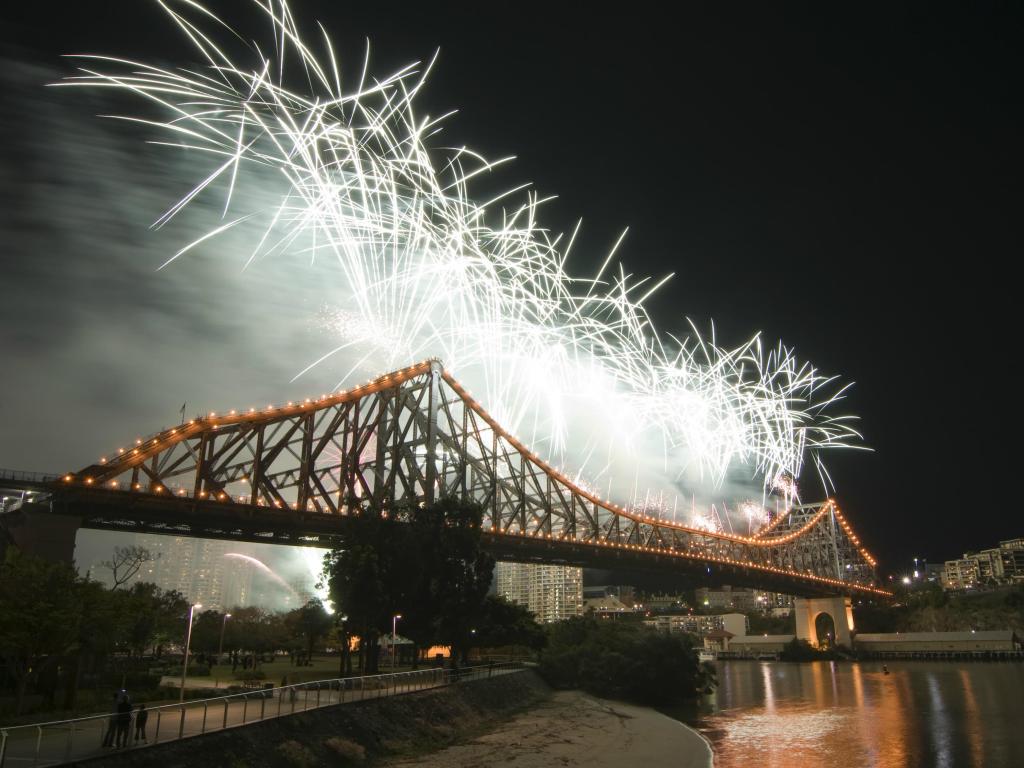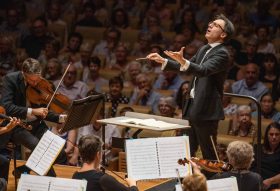Climatic fireworks on Brisbane’s Story Bridge during Riverfire; photo by Warren Chan via Shutterstock.
Once so common a trope as to have inspired a feature film, 2007’s All My Friends Are Leaving Brisbane, the notion that creative Queenslanders have to move south to Sydney or Melbourne in order to sustain a career appears to be declining.
Anecdotal evidence, including the growth of the festival sector in Brisbane, the Gold Coast and beyond, is backed up by data collected by the Australian Bureau of Statistics and published by Arts Queensland, which documents a 9% percent increase since 2006 of Queenslanders whose main occupation is a cultural one – with the arts the main driver of such growth.
So could Queensland be poised to wrest the much-vaunted ‘creative state’ title from one of its more populous southern cousins? And why are we witnessing such a boom in the state’s creative sectors?
Kevin Wilson, Curator, QUT Art Museum pragmatically suggests that one of the reasons for Queensland’s creative growth is that Sydney and Melbourne have become too expensive for artists to live in. He also points to a sense of regeneration, as Queensland artists and organisations recover from the arts cuts inflicted by the previous LNP Government.
‘I think that there was a real sense of depression in the arts community with the Newman Government … [Now] l think that the new breed of artists are starting to build from scratch and you will see more artist initiatives popping up. The Gold Coast has gained some momentum in the arts via the Commonwealth Games and generally in Queensland, gradually more public art is again being commissioned (now regional areas are pulling their weight),’ Wilson said.
Read: Hung by feeling – doing it Louise Hearman’s way
Hamish Sawyer, Gallery Curator, Caloundra Regional Gallery, believes that Queensland has ‘a younger culture than Sydney or Melbourne,’ resulting in a greater willingness to take risks and try something different.
‘A good example of this is the Queensland Art Gallery’s decision back in the early 90s to focus on contemporary art from the Asia Pacific region, with the Asia Pacific Triennial. At the time no other institution was looking at the culture of the region and even now the APT is a clear point of difference and strength for QAGOMA,’ Sawyer said.
Read: The art of migration travels to regional Queensland
Like Wilson, he also believes that the high cost of living in other states is having a positive impact on Queensland. ‘The cost of living in Sydney and Melbourne and improvements in technology have also played a role in keeping creatives in Brisbane or encouraging them to return. It’s [also] much easier to be connected with what’s going on elsewhere now than it was previously,’ Sawyer added.
A creative history
It would be easy to mistake the state’s artistic vitality as a new development, but Queensland has always been a creative state, as Cr Geoff McDonald, Toowoomba Regional Council points out.
‘When we start to discuss all these things we need to look to the past to appreciate the kind of future that we can have. All those people who have been at the top of their game in any genre of art and who have come from Queensland, it doesn’t go understated to say we are certainly a creative state when it comes to the arts,’ said McDonald.
‘Toowoomba had the first national female pianist in Australia in the 1800s. There’s a whole heap of history like that to be uncovered. I think it is about the rich tapestry of Queensland that we have, it comes from our geography or landscape, it is through the different cultural backgrounds that we have, it is certainly our Indigenous heritage which is very strong and equal to any other state,’ he said.
Read: Why our cultural centres can be regional
That Indigenous heritage is celebrated at Cairns Indigenous Art Fair (CIAF), a three-day festival which draws crowds in excess of 50,000. While the traditional tourism model focuses on the state’s beaches, reefs and rainforest, CIAF represents a valuable opportunity to experience the culltural and creative side of Queensland.
Vanessa Gillen, General Manager, CIAF said: ‘It’s about getting exposure for our artists on a national scale. These art communities are so remote they are not really that available, but you can see them all at once at CIAF.’
Read: Leading by celebrating difference
Visitors to Queensland Art Gallery (QAG) also have the opportunity to see an important overview of an artistic movement – in this instance works by the iconic American painter Georgia O’Keeffe and pioneering Australian artists Margaret Preston and Grace Cossington Smith.
Now in its final weeks, O’Keeffe, Preston, Cossington Smith: Making Modernism is a rare opportunity to examine the work of three artists whose practice was coming of age in the 1920s and 30s, decades of great social change and transition. The resonances with contemporary Queensland are obvious.
‘We didn’t choose Preston and Cossington Smith because they were women – they were great artists,’ said Lesley Harding, curator at Heide, where the exhibition was first presented. ‘These three artists made contributions that didn’t emphasise their gender but encouraged people to look at their work from other positions,’
Read: The familiar can also be radical
David Pratt, Chief Executive of Queensland Symphony Orchestra (QSO) is a relatively recent arrival to the state, and said he was initially surprised by the vitality of its creative sector.
‘Coming into this community, I just didn’t understand the depth, the quality and the range of artistic programming in this community. It’s quite extraordinary,’ he said.
QSO is keen to do more to help the sector grow, Pratt added. ‘It’s important for us as an orchestra, where we use obviously our core orchestra but also casuals and other talent, that we access that talent and we keep them engaged in the things that we’re doing as Queensland’s largest performing arts organisation.’
Read: How Queensland Symphony Orchestra’s 70th anniversary is driving its future

Dancenorth: image by Amber Haines
Arts worker Deanna Smart is another newcomer to Queensland, having recently moved to Townsville to take up the position of General Manager at contemporary dance company Dancenorth. She notes that it’s not just Brisbane’s creative culture that is flourishing; it’s the state as a whole – and consequently artists are moving into regional towns and centres to make work.
‘There are a whole range of reasons that people work in the arts in regional areas. The cost of living is better, as it the quality of life. Councils and groups such as Arts Queensland create opportunities to be an artist in regional areas. There is more support for artistic products, and to encourage audiences to retain an interest in the arts,’ said Smart.
‘Building audience literacy is also important. Venues are taking more risks in programming contemporary work. There is a real desire to show contemporary work, not just to program musicals and text-based works, but to throw more challenging pieces into the mix.’
Read: Dancing from Poruma Island to Paris
It’s not just regional venues that are more open to creative risks; Queensland’s regional audience are equally engaged and willing to embrace the new, according to Lindy Hume, Artistic Director, Opera Queensland.
‘When we do our regional tours, the really excellent productions that we take out on tour with the excellent casts and QSO and so forth – the audiences in regional centres have a much more of a sense of “this is just a really exciting piece of theatre and music”. There’s no snobbery – it’s just a lot more authentic,’ she said.
Read: Gilbert & Sullivan’s Ruddigore, or the Witch’s Curse!
Future challenges
Todd MacDonald, Artistic Director of La Boite Theatre Company, recognises that growth is occurring, but notes there are still challenges for actors and theatre-makers in Queensland – particularly in Brisbane, where creative work is constricted by the city’s relatively small population. ‘That said, there are a very strong group of actors in Brisbane who have made and live their career here,’ he explained.
‘All I’m saying is that the opportunities are less. And that doesn’t mean going from gig to gig – it means finding a sustainable way to stay in the creative industries. Now that can be voiceover, it can be doing film and TV, it can be doing ads, and the actual facts are that the advertising industry is predominantly run out of Melbourne and Sydney.’
One solution MacDonald has developed is to provide greater opportunities for acting graduates within La Boite productions, such as an upcoming staging of the Australian classic Blackrock, by Nick Enright, which will star newly graduated QUT Creative Industries students performing alongside professional actors.
‘We’re constantly wanting to influence the way young graduates come out into the industry and give them opportunities, so why not actually really embrace that?’ MacDonald said.
Read: In Blackrock, graduate students cross to the dark side

La Boite’s Blackrock: image by Dylan Evans
Kris Stewart, Artistic Director of Brisbane Powerhouse, agrees that there is a palpable sense of momentum in Queensland’s cultural sector, and notes that there are two main forces at play when it comes to the state’s creative identity.
‘You have a place that has always been used to doing things themselves. Across history it has been sort of a maverick state that is always willing to go its own way. I think that can be really interesting and there are a lot of challenges here,’ said Stewart.
‘One that quite often gets brought up is that there is a real inequity around the amount – Queensland’s tax base is 20% of the population but normally on average sees about 9% in terms of cultural investment coming back here. Because of that, it means I think you have a lot more scrappier small to mediums and independents that are willing to make the work they want to do. If they want to do it, they just do it. There’s not really the same sense of waiting until you get the tap on the shoulder.’
Read: A foot in New Farm and a foot in New York
Stewart hopes one day to see the vibrancy of Queensland’s cultural sector matched by greater federal recognition of the quality of work that is happening in the state.
‘At this year’s Sydney Festival there was a whole range of Queensland companies who were represented: Hot Brown Honey, Circa, and Company 2. Brisbane, with Montreal, is probably the best circus city in the world and so there are these companies that are making this work and then taking that internationally … and the more visibility we can help bring to these artists I think the better it is culturally for the city itself,’ Stewart concluded.





